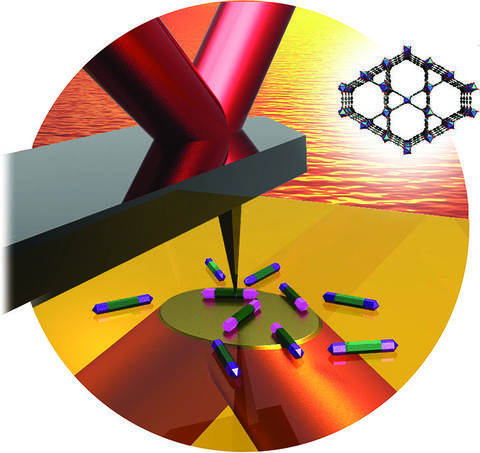Looking Inside: Assessing the Chemical Composition of a Metal-Organic Framework with Nanoscale Resolution

Researchers from the NIST Center for Nanoscale Science and Technology (CNST), in collaboration with researchers from University of Lyon, France, have applied a novel microscopy technique to characterize metal-organic framework (MOF) materials, potentially opening a pathway for engineering the chemical properties of these materials at the nanoscale.* MOFs are composed of metal ions connected by organic linker molecules to form 3D-crystalline networks of nanopores with extraordinarily high surface areas, leading to applications in catalysis, chemical separation, and sensing. This novel characterization was made possible with a unique combination of wavelength tunable lasers and an atomic force microscope available to users at the CNST.
Most MOFs consist of just two types of building blocks, one metal ion and one organic linker. Recently, chemists have included mixtures of linkers in order to obtain and fine tune new chemical properties in the resulting structures, which are called MixMOFs. Until now, however, the limited resolution of conventional techniques has impeded progress in understanding MixMOFs sufficiently to optimize them for desired applications.
To overcome these limitations, the researchers used photothermal induced resonance (PTIR), a novel technique which combines the lateral resolution of atomic force microscopy with the chemical specificity of infrared spectroscopy, to map the chemical composition of individual In-MIL-68 MixMOF micro-crystals with nanoscale resolution. These MixMOFs are typically synthesized directly from solution or by linker exchange, creating crystals whose chemical homogeneity was previously not known. Results show that for MixMOFs prepared using these methods, the micro-crystals are homogeneous down to length scales of approximately 100 nm. According to Andrea Centrone, a Project Leader in the CNST's Energy Research Group, "understanding whether MOF crystals are homogeneous or not is important for applications because homogeneity in the distribution of active sites within a crystal is a prerequisite for designing advanced catalytic materials while heterogeneity could be advantageous for chemical separation."
The researchers also reported a new in situ synthesis process for MOF crystals with linker concentration gradients that are sub-micron in size. Beginning with MOF seed crystals made with one type of organic linker, the researchers add a solution containing a second linker, causing the growth of MixMOFs at the ends of the rod-shaped seed crystals. The confinement of the synthesis between two transparent surfaces enables anisotropic crystal growth and allows for in situ monitoring. The crystals are then analyzed using PTIR to determine the linker distribution. According to Centrone, "for the first time we can take a look into MixMOF single crystals and map the distribution of the linkers."
The researchers believe that the use of the PTIR technique will stimulate MixMOF research, and help scientists improve these materials for use in a range of applications.
*Assessing chemical heterogeneity at the nanoscale in mixed-ligand metal–organic frameworks with the PTIR technique, A. M. Katzenmeyer, J. Canivet, G. Holland, D. Farrusseng, and A. Centrone, Angewandte Chemie International Edition 53, 2852–2856 (2014).
NIST Publication Database Journal Web Site

